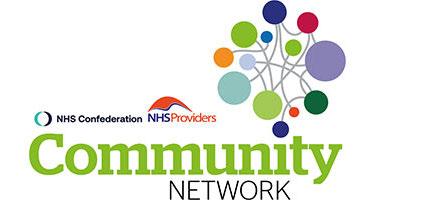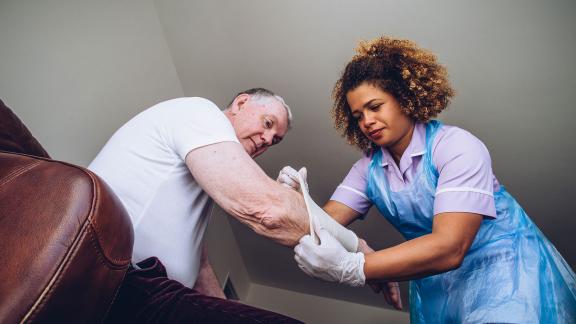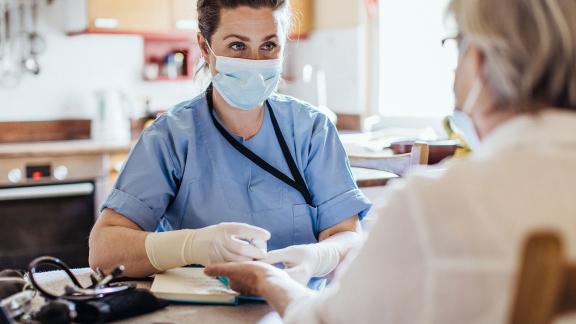Urgent community response in Warrington

In the Warrington place-based partnership, the team has worked closely with the local technology provider to implement a system that enables 999 call handlers to divert calls directly into urgent community response (UCR) teams.
The case study is produced by the Community Network, which is hosted by the NHS Confederation and NHS Providers.
Key benefits and outcomes
- Access to other community services that can support people to stay and home, as well as providing preventative measures for future issues.
- Support for people to stay in their own homes and reduced pressures on the ambulance service.
- 80 per cent of patients seen by the service are treated at home and are able to remain there.
- Falls pick-up service and UCR are more integrated.
What the system faced
Two years ago, if someone in Warrington pressed their pendant alarm the call handler would have the option of sending the falls pick-up team, referring to 999, or contacting the patient’s family. There were not any alternatives to 999 that enabled the patient to be seen and treated at home. There is considerable pressure on the ambulance service and with patients potentially waiting long periods of time their condition could deteriorate, increasingly the likelihood of a hospital visit.
At that time, Warrington didn’t have an urgent community response service. UCR teams often treat patients who are generally unwell, fallers and frail elderly callers and will see them in their own home within two hours of receiving a call. Warrington had a rapid response team but their time was taken up by placing people into intermediate beds. Recognising the need for a service that helped to support people to stay at home, they started their UCR service.
What the system did
Working with The TEC Services Association (TSA), the pendant alarm service piloted a system that enabled call handlers to select the UCR service as an alternative to calling 999. Call handlers had a decision-making tool to support them in choosing the right service for the caller.
Building trust and confidence was essential in making the system work and initially calls were transferred simultaneously to 999 and UCR. This gave the calls handlers confidence that the patient would be seen and gave the UCR service time to build trust with the call handlers and demonstrate the service they could provide. In many cases, the UCR team would arrive ahead of ambulance colleagues and be able to step down an ambulance or escalate where appropriate. Once that trust was built, the call handlers had confidence to select the UCR service where appropriate.
The falls pick-up service has also joined up with the UCR service, with a single manager across both services. They have also started to pair up a UCR clinician with the falls service so that when a patient falls who may need to be seen by a clinician they will visit together, ensuring the patient gets the service they need. UCR also supports the falls pick-up service, responding to escalating need as an alternative to calling an ambulance.
The UCR service is also able to refer patients to other services, such as falls prevention and community nursing services.
Warrington sees the potential in extending the service further and making greater use of technology to support patients in their own homes. The relationship between virtual wards and UCR is one area that is being planned and they have plans to extend the service to care homes. There are currently 200 calls per month from care homes in the area to the ambulance service and UCR could support many of those. Again building trust and confidence will be critical in making that service work.
Results and benefits
- There are 2,600 pendant alarm calls in England per year. In Warrington pendant alarm calls account for a quarter of calls to the UCR service.
- Two years ago the service didn’t exist. It is now seeing or signposting 20 patients per day with the majority of patients (80 per cent) remaining in their own homes.
- There is a UCR network across Cheshire and Merseyside, enabling best practice and learning to be shared across the whole system.
- Ambulances are supported to get to higher acuity calls more quickly
Overcoming obstacles
Each pendant alarm service has a different technology provider and call centre. Locally, pendant alarm calls, UCR and falls are managed within the same portfolio, which has supported the roll out of this work. For national providers, they have been given access to the service finder and can search an address by postcode to find the relevant UCR provider. This is the first time that a non-NHS organisation has been given access to the service finder, and getting to this point has proved challenging.
There was work needed to build trust and confidence with the call handlers in adopting a new pathway as an alternative to calling an ambulance, as well as the UCR team becoming familiar with the falls pick up team.
Takeaway tips
- Building confidence and trust is critical, referrals rely upon their being trust in the service you are providing.
- Establish a relationship with TSA. They have been very supportive and can help you find registered pendant alarm services in your area.
- Create pathways between pendant alarm companies and your urgent community response team.
In terms of challenges with referrals from non-NHS providers, go with a coalition of the willing in the first place, and then bring others along.
Further information
For more information about this case study, contact Caroline Williams, associate director of integrated care at Warrington Borough Council and Warrington and Halton Teaching Hospitals: Caroline.williams59@nhs.net



